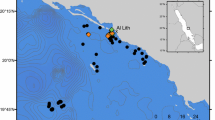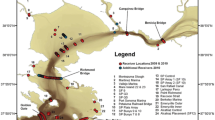Abstract
Despite their large size and frequent occurrence in near-shore tropical habitats, little published information is available on the movements and behaviors of the giant manta ray, Manta birostris, and what factors influence visitation patterns. To examine the movements of manta rays in the Komodo Marine Park, Indonesia, an acoustic array was installed at up to seven sites in the park between 2000 and 2003. A total of 41 acoustic tags were deployed in three separate deployments in 2000, 2001 and 2002. Mantas were recorded in the park for up to 526 days with an average duration of 183 ± 136 days, when mantas made from 3 to 303 individual visits to different sites (median 58 visits). There was a clear preference for three sites that comprised over 90% of manta activity. The most popular site (German Flag) was off the southern tip of Komodo Island in an area with a high degree of bathymetric structure. Examination of the longest records suggests some site preference with 5 of 7 individuals spending greater than 90% of their time at the location where they were tagged. Using a general linear model it was possible to examine the effects of daytime, lunar phase, aggregation site, season and tidal phase on visitation patterns. The vast majority of visits were recorded during daylight hours at all sites. The strongest effects of both the lunar and tidal phase were apparent in the northern sites with the most visits occurring when tidal intensity was the greatest during full and new moons. The strongest seasonal pattern was observed in the south where no mantas were recorded during the first quarter in any year. This coincides with an increase in temperature and reduction of productivity in this region associated with monsoonal shifts. The long-term fidelity indicates that marine-protected areas centered around aggregation sites could help protect this species from overexploitation.








Similar content being viewed by others
References
Alava ERZ, Dolumbaló ER, Yaptinchay AA, Trono RB (2002) Fishery and trade of whale sharks and manta rays in the Bohol Sea, Philippines. In: Fowler SL, Reed TM, Dipper FA (eds) Elasmobranch Biodiversity, Conservation and Management: Proceedings of the International Seminar and Workshop. Sabah, Malaysia, July 1997, pp 132–148
Anderson C (1996) Manta tagging starts in the Maldives. Shark News 7:6
Arnold G, Dewar H (2001) Electronic tags in marine fisheries research: a 30-year perspective. In: Seibert J, Nielsen J (eds) Electronic tagging and tracking in marine fisheries. Kluwer , Dordrecht, pp 7–64
Bigelow HB, Schroeder WC (1953) Fishes of the Western North Atlantic. Part two: Sawfishes, Guitarfishes, Skates and Rays. Memoir Sears Foundation for Marine Research, Number 1. Yale University, New Haven, pp 481–515
Blaxter JHS (1974) The role of light in the vertical migration of fish—a review. In: Evans GC, Bainbridge R, Rackham O (eds) Light as an ecological factor, II. Blackwell, Oxford, pp 189–210
Clark CW, Croll DA, Acevedo A, Urban-Ramirez J (2000) Multi-modal surveys of fin whales in the Sea of Cortez, Mexico. J Acoust Soc Am 108:2539
Compagno LJV (1999) Checklist of living elasmobranchs. In: Hamlett WC (ed) Sharks, skates, and rays: the biology of elasmobranch fishes. John Hopkins University Press, Maryland, pp 471–498
Dewar H (2002) Preliminary report: manta ray harvest in Lamakera. Report to the World Wildlife Fund. http://www.tnc-seacmpa.org/downloads/alor%20-%20eBook.pdf
Domeier ML, Colin PL (1997) Tropical reef fish spawning aggregations: defined and reviewed. Bull Mar Sci 60:698–726
Domeier ML, Kiefer D, Nasby-Lucas N, Wagschal A, O’Brien F (2005) Tracking Pacific bluefin tuna (Thunnus thynnis orientalis) in the northeastern Pacific with an automated algorithm that estimates latitude by matching sea-surface-temperature data from satellites with temperature data from tags on fish. Fish Bull 103:292–306
Domeier ML, Nasby N (2006) Annual re-sightings of photographically identified white sharks (Carcharodon carcharias) in an eastern Pacific aggregation site (Guadalupe Island, Mexico). Mar Biol. doi:10.1007/s00227-006-0380-7
Duffy CAJ, Abbott D (2003) Sightings of mobulid rays from northern New Zealand, with confirmation of the occurrence of Manta birostris. NZ J Mar Freshwat Res 37:115–121
Economakis AE, Lobel PS (1998) Aggregation behavior of the grey reef shark, Carcharhinus amblyrhynchos, at Johnston Atoll, Central Pacific Ocean. Environ Biol Fishes 51:129–139
Field AL, Gordon AL (1996) Tidal mixing structures in the Indonesia Seas. J Physic Oceanog 26:1924–1937
Fujita T (2006) A study of tuna bycatch using correspondence analysis. Masters Thesis University of California Los Angeles, California. 2006
Garcia MA, Hall MA (1997) Spatial and seasonal distribution of bycatch in the purse seine tuna fishery in the eastern Pacific Ocean. In: Fisheries Bycatch: Consequences and Management, Dearborn MI, Alaska Sea Grant Program Report 97–02, pp 46–49
Graham RT, Roberts CM, Smart JCR (2006) Diving behaviour of whale sharks in relation to a predictable food pulse. J R Soc Interface 3:109–116
Hahude AG, Gordon AL (1996) Thermocline stratification within the Indonesian Seas. J Geophys Res 101:12401–12409
Hernández-León S, Almeida C, Yebra L, Arístegui J, Fernández de Puelles ML, García-Braun J (2001) Zooplankton abundance in subtropical waters: is there a lunar cycle? Sci Mar 65:59–64
Heupel MR, Simpfendorfer CA (2005) Quantitative analysis of aggregation behavior in juvenile blacktip sharks. Mar Biol 147:1239–1249
Heyman WD, Graham RT, Kjerfve B, Johannes RE (2001) Whale sharks, Rhincodon typus, aggregate to feed on fish spawn in Belize. Mar Ecol Prog Ser 215:275–282
Holland KN, Wetherbee BM, Peterson JD, Lowe CG (1993) Movements and distribution of hammerhead shark pups on their natal grounds. Copeia 1993:495–502
Holm KJ, Burger AE (2002) Foraging behavior and resource partitioning by diving birds during winter in areas of strong tidal currents. Waterbirds 25:312–325
Homma K, Maruyama T, Itoh T, Ishihara H, Uchida S (1997) Biology of the manta ray, Manta birostris, Walbaum, in the Indo-Pacific. In: Séret B, Sire JY (eds) Proceedings of the 5th Indo-Pacific Fish Conference, Nouméa. Soc Fr Ichthyol, Paris, pp 209–216
Kinkade C, Marra J, Langdon C, Knudson C, Ilahude AG (1996) Monsoonal differences in phytoplankton biomass and production in the Indonesian Seas: tracing vertical mixing using temperature. Deep Sea Res I 44:581–592
Klimley AP, Nelson DR (1984) Diel movement patterns of the scalloped hammerhead shark (Sphyrna lewini) in relation to El Bajo Espiritu Santo: a refuging central-position social system. Behav Ecol Sociobiol 15:45–54
Klimley AP, Butler SB, Nelson DR, Stull AT (1988) Diel movements of scalloped hammerhead sharks, Sphyrna lewini, to and from a seamount in the Gulf of California. J Fish Biol 33:751–761
Klimley AP, Anderson S (1996) Residency patterns of white sharks at the South Farallon Islands, California. In: Klimley AP, Ainly DG (eds) Great white sharks, the biology of Carcharodon carcharias. Academic Press, San Diego, pp 365–373
Klimley AP, Halloway CF (1999) School fidelity and homing synchronicity of yellowfin tuna, Thunnus albacares. Mar Biol 133:307–317
Last PR, Stevens JD (1994) Sharks and rays of Australia. CSIRO, Australia
Marshall A, Ishihara H, Dudley SFJ, Clark TB, Jorgensen S, Smith WD, Bizzarro JJ (2006) Manta birostris. In: IUCN 2006. 2006 IUCN Red List of Threatened Species. http://www.iucnredlist.org
McCullagh P, Nelder JA (1989) Generalized linear models, 2nd edn. Chapman Hall, London
Mendes S, Turrell WR, Lutkebohle T, Thompson PM (2002) Influence of the tidal cycle and a tidal intrusion front on the spatio-temporal distribution of coastal bottlenose dolphins. Mar Ecol Prog Ser 239:221–229
Musick J A (1999) Ecology and conservation of long-lived marine animals. Am Fish Soc Symp 23:1–10
Musick JA, Burgess G, Cailliet G, Camhi M, Fordham S (2000) Management of sharks and their relatives (Elasmobranchii). Fisheries 25:9–13
Prince ED, Goodyear CP (2006) Hypoxia-based habitat compression of tropical pelagic fishes. Fish Oceanogr 15:451–464
Robinson CJ, Gomez-Gutierrez J (1998) Daily vertical migration of dense deep scattering layers related to the shelf-break area along the northwest coast of Baja California, Mexico. J Plankton Res 20:1679–1697
Romanov EV (2002) Bycatch in the tuna purse-seine fisheries of the western Indian Ocean. Fish Bull 100:90–105
SAS Institute, Inc (1993) SAS/STAT Software: The GENMOD Procedure, Release 6.09 SAS Technical Report P–243. SAS Institute Inc. Cary, North Carolina
Santos RS, Porteiro FM, Barreiros JP (1997) Marine fishes of the Azores: annotated checklist and bibliography. Bull Univ Azores Supplement 1, p 244
Shanks AL (1983) Surface slicks associated with tidally forced internal waves may transport pelagic larvae of benthic invertebrates and fishes shoreward. Mar Ecol Prog Ser 13:311–315
Sims DW, Quayle VA (1998) Selective foraging behaviour of basking sharks on zooplankton in a small-scale front. Nature 393:460–464
Sims DW (1999) Threshold foraging behaviour of basking sharks on zooplankton: life on an energetic knife edge? Proc R Soc Lond B 266:1437–1443
Sims DW, Nash JP, Morritt D (2001) Movements and activity of male and female dogfish in a tidal sea lough: alternative behavioural strategies and apparent sexual segregation. Mar Biol 139:1165–1175
Smith JLB, Smith MM (1963) The fishes of Seychelles. Rhodes University, Grahamstown
Sokal RR, Rohlf FJ (1995) Biometry, 3rd edn. W. H. Freeman, New York
Sugimoto T (1975) Effects of boundary geometries on tidal currents and tidal mixing. J Oceanogr Soc Jpn 31:1–14
Sundstrom LF, Gruber SH, Clermont SM, Correia JPS, de Marignac JRC, Morrissey JF, Lowrance CR, Thomassen L, Oliveira MT (2001) Review of elasmobranch behavioral studies using ultrasonic telemetry with special reference to the lemon shark, Negaprion brevirostris, around Bimini Islands, Bahamas. Environ Biol Fishes 60:225–250
Tomczak M, Godfrey JS (1994) Regional oceanography: an introduction. Permagon, Tarrytown
Tont SA (1975) Deep scattering layers: patterns in the Pacific. CALCOFI Rep 18:112–117
Voegeli FA, Smale MJ, Webber DM, Andrade Y, O’Dor RK (2001) Ultrasonic telemetry, tracking, and automated monitoring technology for sharks. Environ Biol Fishes 60:267–281
White W, Giles J, Dharmadi, Potter I (2006) Data on the bycatch fishery and reproductive biology of mobulid rays (Myliobatiformes) in Indonesia. Fish Res 82:65–73
Wilson SG, Taylor JG, Pearce AF (2001) The seasonal aggregation of whale sharks at Ningaloo Reef, Western Australia: currents, migrations and the El Niño/Southern Oscillation. Environ Biol Fishes 61:1–11
Acknowledgments
We thank the Pfleger Foundation and The Nature Conservancy for its support of this project. The field research could not have been conducted without the assistance of The Nature Conservancy staff and Komodo Marine Park Rangers based on Flores, Indonesia who spent long hours on the water. We also thank Russ Vetter and Jason Larese for their valuable comments on the manuscript. The conclusions stated herein reflect the opinions of the authors and not the National Oceanographic and Atmospheric Administration. Experiments were conducted in accordance with current laws in Indonesia.
Author information
Authors and Affiliations
Corresponding author
Additional information
Communicated by R. J. Thompson.
Rights and permissions
About this article
Cite this article
Dewar, H., Mous, P., Domeier, M. et al. Movements and site fidelity of the giant manta ray, Manta birostris, in the Komodo Marine Park, Indonesia. Mar Biol 155, 121–133 (2008). https://doi.org/10.1007/s00227-008-0988-x
Received:
Accepted:
Published:
Issue Date:
DOI: https://doi.org/10.1007/s00227-008-0988-x




